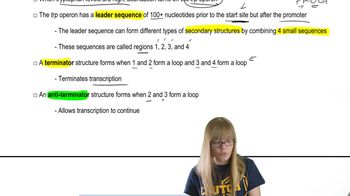A repressible operon system, like the trp operon, contains three genes, G, Z, and W. Operon genes are synthesized when the end product of the operon synthesis pathway is absent, but there is no synthesis when the end product is present. One of these genes is an operator, one is a regulatory protein, and the other is a structural enzyme involved in synthesis of the end product. In the table below, '+' indicates that the enzyme is synthesized by the operon and '−' means that no enzyme synthesis occurs. Use this information to determine which gene corresponds to each operon function.
Table of contents
- 1. Introduction to Genetics51m
- 2. Mendel's Laws of Inheritance3h 37m
- 3. Extensions to Mendelian Inheritance2h 41m
- 4. Genetic Mapping and Linkage2h 28m
- 5. Genetics of Bacteria and Viruses1h 21m
- 6. Chromosomal Variation1h 48m
- 7. DNA and Chromosome Structure56m
- 8. DNA Replication1h 10m
- 9. Mitosis and Meiosis1h 34m
- 10. Transcription1h 0m
- 11. Translation58m
- 12. Gene Regulation in Prokaryotes1h 19m
- 13. Gene Regulation in Eukaryotes44m
- 14. Genetic Control of Development44m
- 15. Genomes and Genomics1h 50m
- 16. Transposable Elements47m
- 17. Mutation, Repair, and Recombination1h 6m
- 18. Molecular Genetic Tools19m
- 19. Cancer Genetics29m
- 20. Quantitative Genetics1h 26m
- 21. Population Genetics50m
- 22. Evolutionary Genetics29m
12. Gene Regulation in Prokaryotes
Tryptophan Operon and Attenuation
Problem 25a
Textbook Question
What is the likely effect of each of the following mutations of the trpL region on attenuation control of trp operon gene transcription? Explain your reasoning.
Region 3 is deleted.
 Verified step by step guidance
Verified step by step guidance1
Understand the role of the trpL region in attenuation control: The trpL region is part of the leader sequence of the trp operon and contains sequences that form stem-loop structures (regions 1-4). These structures are critical for regulating transcription termination based on tryptophan levels.
Identify the function of Region 3: Region 3 is involved in forming the antiterminator stem-loop (with Region 2) and the terminator stem-loop (with Region 4). The antiterminator prevents transcription termination, while the terminator promotes it.
Analyze the effect of deleting Region 3: Without Region 3, the antiterminator stem-loop cannot form, and the terminator stem-loop (Region 3-4 pairing) is also disrupted. This likely prevents attenuation control, as the operon cannot respond to tryptophan levels effectively.
Consider the transcriptional outcome: If attenuation control is lost, transcription of the trp operon genes may proceed unchecked, regardless of tryptophan levels. This could lead to overproduction of tryptophan biosynthesis enzymes even when tryptophan is abundant.
Summarize the reasoning: The deletion of Region 3 disrupts the structural elements required for attenuation control, impairing the operon's ability to regulate transcription termination in response to tryptophan availability.
 Verified video answer for a similar problem:
Verified video answer for a similar problem:This video solution was recommended by our tutors as helpful for the problem above
Video duration:
3mPlay a video:
Was this helpful?
Key Concepts
Here are the essential concepts you must grasp in order to answer the question correctly.
Attenuation in Gene Regulation
Attenuation is a regulatory mechanism in prokaryotes, particularly in the trp operon, that controls gene expression based on the availability of tryptophan. It involves the formation of specific RNA structures during transcription that can either promote or inhibit the continuation of transcription, depending on the concentration of tryptophan in the cell.
Recommended video:
Guided course

Trp Attenuation
trp Operon Structure
The trp operon consists of a set of genes responsible for tryptophan biosynthesis in bacteria. It includes regulatory regions such as the leader sequence (trpL), which contains sequences that can form alternative secondary structures, influencing whether transcription is terminated early or continues to produce the enzymes needed for tryptophan synthesis.
Recommended video:
Guided course

Trp Attenuation
Role of Region 3 in Attenuation
Region 3 of the trpL sequence plays a critical role in the formation of the RNA secondary structures that determine whether transcription will be terminated. If Region 3 is deleted, it disrupts the ability to form the necessary structures for attenuation, likely leading to increased transcription of the trp operon genes, regardless of tryptophan levels.
Recommended video:
Guided course

Trp Attenuation
Related Videos
Related Practice
Textbook Question
1081
views


